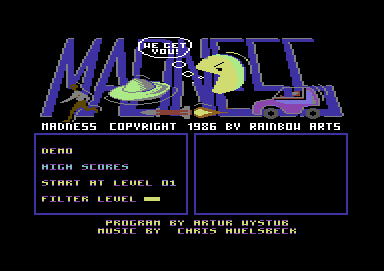Retro Replay Review
Gameplay
Madness delivers a fast-paced platforming experience built around precision, timing, and strategic route planning. Each of the 30 screen-sized levels challenges you to activate every torch scattered throughout the map before making your way to the exit. With a generous but unforgiving time limit ticking down, the pressure to balance speed and caution is constant, making each playthrough feel like a race against both the clock and your own instincts.
Enemies populate the levels in both predictable and unpredictable ways. Many foes patrol set paths, allowing you to time your movements and slip by unscathed. However, a handful of more aggressive adversaries will lock onto your sprite and pursue you relentlessly, turning once-safe corridors into nerve-wracking gauntlets. Learning enemy patterns and prioritizing which torches to light first becomes crucial as levels morph from simple runs into intricate puzzles.
As you progress, level design evolves to introduce new mechanics and obstacles. Moving platforms, crumbling tiles, and hidden switches force you to think several steps ahead, avoiding dead ends that could spell disaster as the clock winds down. The necessity of route optimization shines through in later stages, rewarding players who study layouts and master shortcuts. This layered difficulty curve keeps Madness perpetually engaging without ever feeling unfair.
Graphics
Visually, Madness opts for clean, retro-inspired pixel art that emphasizes clarity over flash. Each level’s background is distinct yet unobtrusive, allowing you to focus entirely on the foreground elements: torches, platforms, and enemy sprites. The minimalist color palette reinforces the game’s fast tempo, ensuring that even in hectic moments you can quickly distinguish hazards from safe ground.
Enemy designs are deliberately varied, from slow-moving patrollers to lightning-fast chasers, each with a unique silhouette that helps players identify threats at a glance. Animations are crisp and economical, conveying motion without unnecessary frames or distracting flourishes. This straightforward approach keeps the gameplay loop sharp and the frame rate rock solid, even when multiple hazards converge on screen.
Lighting effects around the torches add a subtle atmospheric touch, casting brief glows and shadows that heighten the sense of urgency. While the overall presentation may not dazzle with next-gen shaders, its cohesive art direction and responsive visual feedback serve the core gameplay impeccably. In Madness, less truly is more when every millisecond counts.
Story
Madness doesn’t lean heavily on narrative, instead weaving a skeletal thread of motivation through its level progression. You are cast as an unnamed wanderer trapped in a labyrinth of flickering torches, each blaze representing a milestone on your escape path. The absence of cutscenes or lengthy exposition keeps the action uninterrupted, ensuring players remain immersed in the immediate challenge before them.
Despite its minimalism, the game’s environments hint at a broader, untold lore. Crumbling stone walls, vines creeping through cracked mortar, and hidden alcoves suggest an ancient world abandoned and reclaimed by nature. These environmental cues provide enough intrigue to spark the imagination, allowing players to project their own narratives onto the unfolding platforming ballet.
Occasional visual storytelling—such as a toppled statue or a scorched doorway—adds texture without derailing momentum. By the time you reach the final screens, the sparse narrative framework feels fitting: a simple ordeal of endurance and wit that never outstays its welcome. In Madness, story is the silent partner to gameplay, quietly setting the stage for your trials without overshadowing them.
Overall Experience
Madness excels as a concentrated platforming challenge, marrying streamlined mechanics with surprisingly deep puzzle elements. Each level feels like a microcosm of speedrunner’s paradise, where trial-and-error learning and split-second decisions determine success or failure. The immediate satisfaction of lighting the last torch and beating the timer creates an addictive loop that beckons you to tackle just one more stage.
The learning curve is brisk yet fair. Early screens introduce core concepts, while later levels push your mastery of momentum, enemy behavior, and spatial awareness to the brink. Checkpoints are generous enough to reduce frustration, yet infrequent enough to maintain tension. For players who relish perfecting their runs or shaving off precious seconds, Madness offers plenty of incentive to return and improve.
Though it doesn’t boast multiplayer modes or sprawling open worlds, Madness knows its strengths and hones them to perfection. Its bite-sized levels are ideal for quick play sessions or marathon runs alike. Whether you’re a platforming purist seeking tight, unrelenting challenges or a newcomer looking for a visually clear and mechanically honest experience, Madness stands as a testament to focused design and arcade-style thrills.
 Retro Replay Retro Replay gaming reviews, news, emulation, geek stuff and more!
Retro Replay Retro Replay gaming reviews, news, emulation, geek stuff and more!









Reviews
There are no reviews yet.